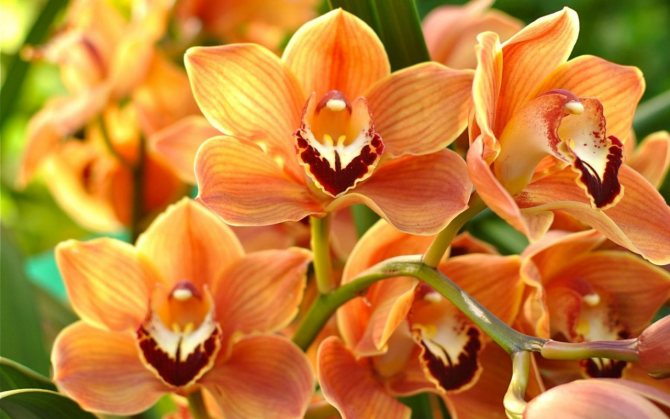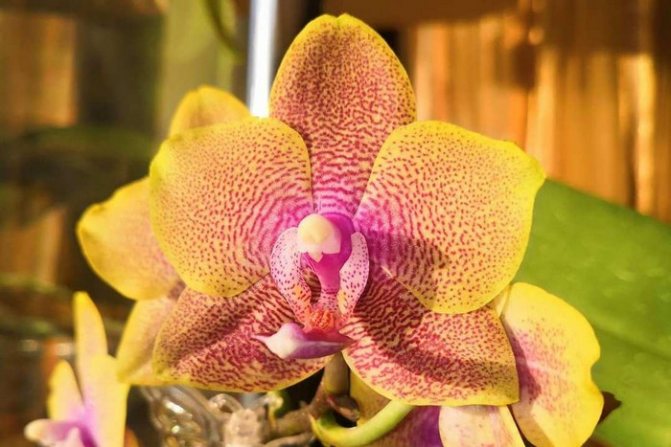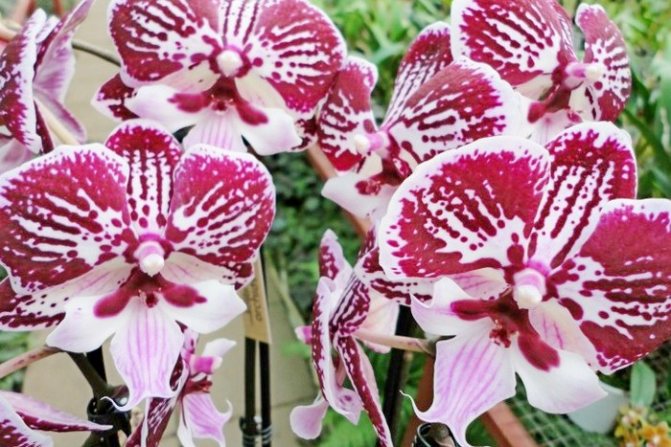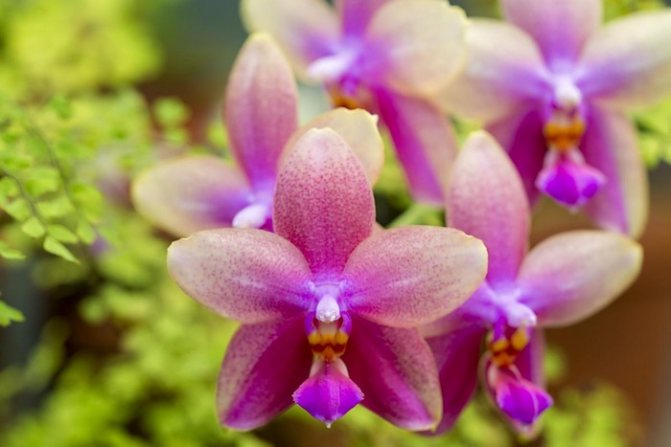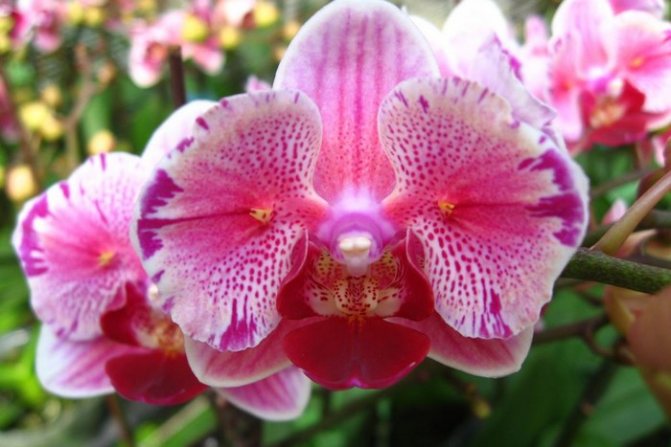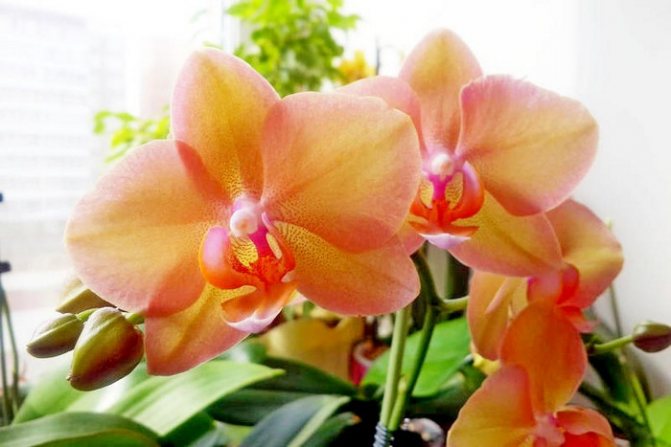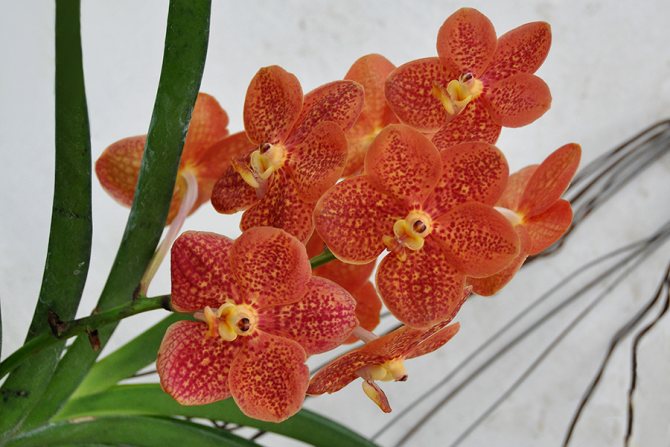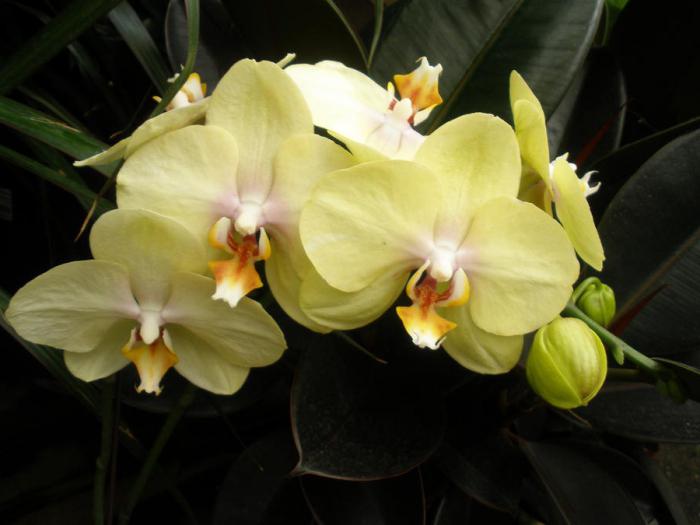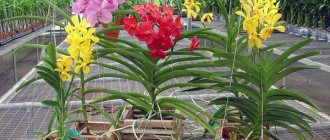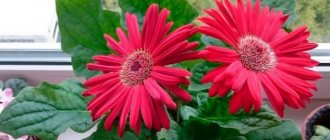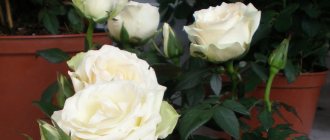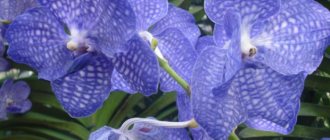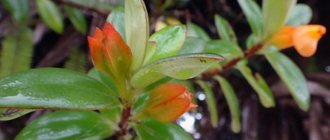How to choose?
The most varied shades of orchids are called orange. Dark yellow with orange tints, orange with tints of red and pink, and scarlet are shades of the orchid, which is sold under the name orange.
When buying an orange orchid, be careful not to be fooled by the florists. They often pass off a painted flower as a real one. Such a plant will either bloom white or die.
When choosing an orchid in the store, pay attention to the roots... Their color should be natural, there should be no puncture under the leaves, on the peduncle and on the neck of the flower.
Description
Phalaenopsis is an epiphytic herbaceous shrub. Large leaves turn into thick, strong roots, which have the following features:
- contain chlorophyll;
- have a spongy structure;
- covered with a wax film;
- participate in photosynthesis;
- serve as a support;
- provide nutrients;
- turn green when saturated with moisture.
In the spring-autumn season, peduncles appear from the axils of the fleshy oval-shaped leaves. Their structure depends on the species. They are long, short, straight, curved, branched, drooping.
During the growing season, 1-3 leaves grow on the shoot. They last for several years. As new foliage forms, the old one dies off. The length depends on the phalaenopsis variety - 0.2-1 m. Color: light green, dark green, spotted.
On one plant, 5-60 flowers with a diameter of 2-15 cm are formed. They resemble a butterfly in shape and pattern on the petals. There are round, star-shaped flowers. The natural color of Phalaenopsis is white.
Varieties with bright colors and their photos
There are a huge number of varieties of orange orchids, but among them there are several species that stand out for their beauty. These flowers are easy to grow at home.
Cattleya

The most beautiful of the orange orchids. It has large yellow-red inflorescences and a velvety orange lip. The plant needs temperature changes and abundant watering in summer..
We suggest watching a video about the Cattleya orchid:
Ascocenda
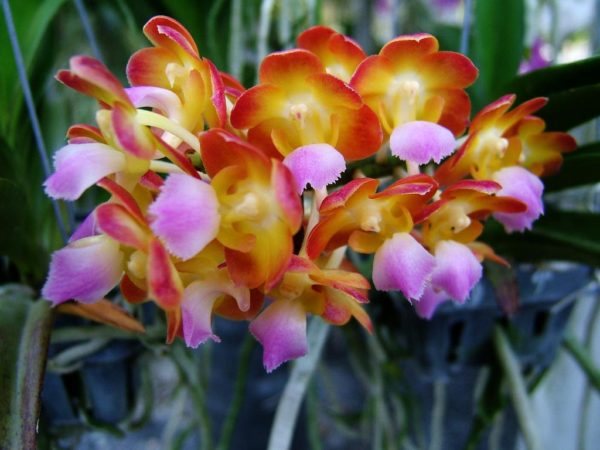

A hybrid bred by crossing Ascocentrum and Wanda plants. The plant has bright orange large inflorescences, which are collected in a brush. Leaves are rich green.
Ascocenda is too picky. It takes a lot of effort to see it bloom and grow it. She needs excellent lighting for at least twelve hours a day, sudden changes in temperature.
Pay particular attention to the fact that you need to water Ascocendra a lot and only with warm water.
We offer to watch a video about the Ascocendre orchid:
Wanda
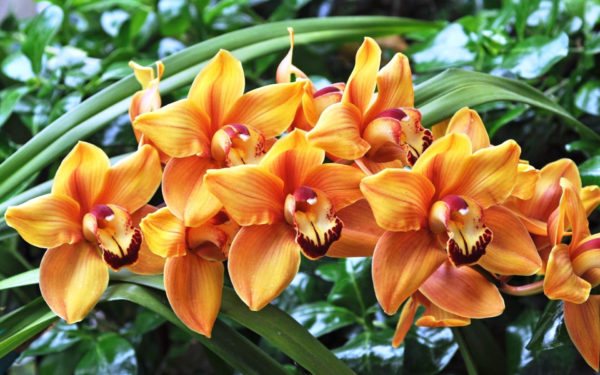

Capricious but popular for its pure orange color. Needs a lot of sunlight, ventilation and fertilization. Loves high humidity. Roots should be left open so they don't rot..
Brassada


A hybrid of hell aurantika and brassia. The bright orange buds of hell of aurantika were inherited by brassade. Loves when it is cool, dark and humid. If you provide it with these conditions, then in the summer you can see how beautiful it will bloom. Her flowers will delight more than a month.
Cymbidium
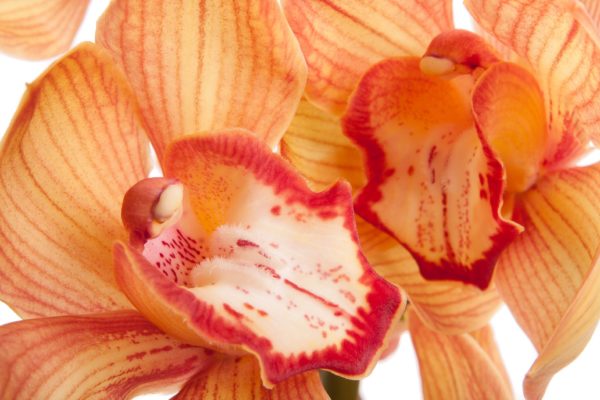

Tall orange orchid with long, pointed leaves.From spring to autumn, watering should be abundant. It is impossible to allow the soil to dry out. The plant does not need high humidity.
We offer you to watch a video about the Tsrimbidium orchid:
Phalaenopsis species
| Variety | Description | Flowering period |
| Amabilis | Two-row leaves of a dark green color. Curved peduncle 1.5 m high. The most profitable variety for crossing. Has a delicate aroma. | October - March. |
| Schilleriana | Silvery flat roots with a pink tip. It amazes with the huge size of speckled leaves. At the same time, up to 200 light pink lilac flowers with a pleasant scent are formed. | May - February. The peak of active flowering is during the winter months. |
| Stewart | A tall plant with a curved peduncle, shiny white roots, variegated leaves, white petals. Up to 60 buds open at the same time. | January March |
| Giant | Tall drooping peduncles with many buds. Petals of various colors. Hard malachite leaves are covered with light specks. In comfortable conditions, it blooms all year round. | Constantly. |
| Deerhorn | Small golden-red flowers with brown spots. The structure is similar to the antlers of a deer. In places where the buds are formed, growths are formed that resemble a ridge. | All year round. |
| Hieroglyphic | Leaves and peduncles of green color. On the white wax petals, strokes similar to hieroglyphs are noticeable. Has a pleasant scent. | Duration - 30 days. |
| Parisha | A milky white variety with a fruity aroma. The short stem is covered with leaves. The flower is made up of a wide lip with a lilac color in the middle. | Continuous. |
| Luddemann | Mini variety with elliptical lettuce leaves. Adult specimens bloom alternately throughout the year. Dense petals are smaller than sepals. Purple, chestnut, light purple strokes are located on the white background. Pronounced pleasant aroma. | Permanent. |
| Sander | The most expensive variety. High drooping stems are decorated with a large number of flowers of various colors. | All year round. The peak of activity is spring - summer. |
| Ambon | 3-5 oval leaves. Peduncles lengthen annually. Petals of variegated shades - on a light background, transverse stripes of brick color. | Constant flowering. The most active phase is summer. |
| Pink | Miniature variety with white, milky, pink flowers. The leaves from the bottom have a reddish tint. | All year round. |
| Horse | Short stem with paired dark green leaves. Pastel pink, purple flowers. | 5 months. |
| Mini Mark "Maria Teresa" | White flowers with orange, bright yellow, brown specks. In the spring, in the fall. | 3 months. |
| Amsterdam Jordan | A rare variety. Pink petals adorn small dark spots. Cherry lip. | All year round. |


Care rules
The plant will take root if it is installed on a windowsill that faces the west or east side. The maximum temperature in summer should not exceed 30 ° C, and in winter not less than + 14 ° C.
Additional lighting will have to be organized if the plant is cold and dark on the window in winter.
The soil for planting an orange orchid must be specially prepared. You will need pine bark, wood coal and sphangun moss. Choose a transparent pot with holes for drainage for the flower, because the presence of air is important for the roots.
Water the orchid with plenty of warm water.... At low temperatures and when there is little light, watering should be done less often so as not to destroy the plant.
Watering orchids
The yellow orchid and its species cousins need special watering. The growth and development of the plant depends on this factor. In its natural environment, the flower does not have direct access to water. Stagnant water and exposure to substances that are in it can be detrimental to the orchid. The soil should be slightly damp. Watering should be regulated depending on the season, air humidity and ambient temperature.It will be better if the land dries up a little than becomes swampy. If the orchid lacks moisture, then its leaves will become shriveled. When over-watered, the leaves turn yellow and the roots rot and disappear. Usually the flower is placed in a container of warm water for 10-15 minutes until the soil becomes moist. It can also be poured from the shower to keep the substrate wet and the liquid spilling out of the holes in the pot. It is necessary that the water is completely out of the pot and does not stagnate.
Transfer


To maintain a healthy root system, the orange orchid must be repotted correctly after it has bloomed. Transplant stages:
- When removing the flower from the pot, do not allow severe damage.
- Wash off the clod of earth with water.
- Remove injured roots.
- Leave stumps when cutting leaves that are withered.
- Dry the flower for three hours before planting.
Thanks to the transplant, the mineral supply will not become impoverished, the acidity will not increase, and the plant will avoid poisoning.
Orchid bloom
Flowers are the main decoration of this plant. The orchid produces a stem about 70 centimeters long, at the end of which there is a peduncle. A healthy, mature plant can produce up to 80 flowers. First, the lateral flowers open, and then the bud opens completely.


The whole process takes about a day. Then the growth of the flower does not stop for several more days. On average, flowering lasts about 3 months. At this moment, it is better not to rearrange the plant and not change the conditions of its maintenance. You can only feed the flower a little.
Pests and diseases
Care for an orange orchid must be correct, otherwise the appearance of pests and diseases will be inevitable. If the leaves of the plant began to turn yellow, then this is a signal of the disease.... Yellowness indicates the wrong temperature, insufficient moisture and light. It is not recommended to supercool the flower for a long time. This leads to his death.
If spots appear on the leaves and a viral disease is detected by a specialist, then the flower must be destroyed. This will help keep other flowers from viruses that can be spread by insects. Viral diseases are incurable.
Bacterial spotting is manifested by dark spots and softened leaves. In this case, the sore spots are cut off and burned with iodine.
Fungal diseases are soil-borne... They are difficult to treat, so it is best to avoid them. If you constantly ventilate the room, avoid excess moisture, do not leave water on the leaves, then such diseases can be prevented.
When the plant is weakened, mealybugs and aphids can colonize it. You can destroy pests only with those preparations that are recommended for orchids.
Reproduction
Only high-quality plants are used, without signs of diseases. The vegetative method is the propagation of phalaenopsis by lateral shoots. They are formed at the root rosette, on the peduncle. In most cases, their appearance is artificially induced.


At the base of the flowering arrow, a sleeping bud is selected, the integumentary scales are removed from it with tweezers. They are treated with a growth stimulant - aloe juice, Epin, Kornevin. To create a greenhouse effect, the peduncle is covered with a plastic bag. The first leaves appear after 60 days. After a month, roots are formed.
The baby is separated from the mother plant, dried for a day. The substrate for planting is selected in fine fractions.
For rooting, greenhouse conditions are created for the seedling - covered with a plastic cap. Suitable temperature for engraftment is + 25 ° C.
Another way of vegetative propagation is by dividing the stem into parts:
- cross section;
- section along the axis;
- combined separation.
The sections are treated with cinnamon, the kidneys - with cytokinin paste, dried, placed in a liquid with a crushed tablet of activated carbon.The water is changed weekly, fertilizer is added - Forte for orchids.
Six months later, a young peduncle appears on the rooted cuttings. He is ready to plant in the substrate.
Temperature regime
As already mentioned, the yellow Phalaenopsis orchid is very unpretentious in terms of the temperature of the content. She feels great in the climate of the apartment. But still, there are some subtleties. A decrease in temperature in winter to 20-25 degrees has a very good effect on its development. In summer, it can be 25-30 degrees.
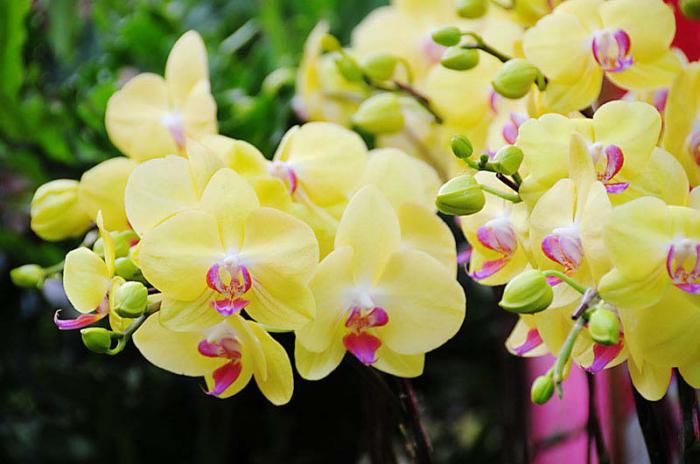

Due to the difference in temperature between day and night of 5-7 degrees, flower buds are born. Prolonged lowering - for several days - up to 10-15 degrees can lead to the death of the plant. If the orchid freezes, then it begins to absorb all the necessary substances and moisture from the leaves. They dry up. Watering in this case will not be beneficial, but will harm. You just need to move the pot to a warmer place.


